The never-ending needs of an old RV

Let me begin by saying that, since Hagerty doesn’t offer insurance for RVs, I’m appreciative that they let me continue to write about my adventures in our little 1996 Winnebago Rialta (which is a Volkswagen Eurovan with a Winnebago camper body on the back—basically a pumped-up Westfalia-style camper but with a real bed, a toilet, and a small shower). Since I began writing these occasional pieces when we bought the Rialta five years ago, whether it’s general observations on owning a small RV, or installing solar panels, or talking about the unspoken underbelly of RV ownership (dumping the tanks), the response has been wonderful, even if some of the comments are sometimes, “Well, my wife and I were thinking about buying a motorhome until we read your piece.”
Hey, if I can’t be a shining example, at least I can be a clear warning.

Here’s why I think these pieces dovetail so well with my others about vintage car ownership and keeping my daily drivers running: I’ve long said that I don’t know how anyone affords a used car, much less a vintage car, much less a boutique oddball vintage car like a Lotus Europa, if they have to pay someone else to work on it every time it needs attention or something breaks. It’s like that with a well-used RV, only it’s worse. Think about it. You’re taking all of the foibles of an old car and adding onto them the quirks of an old house that’s been shaken by driving it down the road. You’re literally dragging around something with a toilet, sink, shower, refrigerator, and stove, and in order for you to have a good, comfortable RV experience and not go running for the nearest hotel room, you’re relying on all of them to work. And that doesn’t include the second-level comforts of a hotel room’s air conditioning, heat, 120-volt appliances, and television. It’s actually a pretty tall order.
As I wrote in that first general observations article five years ago, it used to be that if you wanted a small (21-ish-foot), used, affordable RV that didn’t get single-digit gas mileage and that you could park easily, your choices were the Rialta or its predecessor, the Winnebago LeSharo; one of the many varieties of the Toyota mini-motorhome built on the old Hilux chassis; or the weird and rare Vixen—and not much else. Nowadays, there are seemingly endless motorhome conversions based on the Sprinter, Ram ProMaster, and Ford Transit vans, but these haven’t been around long enough to fall into the $5K–$10K range into which I throw money like old ladies feeding pigeons. And, to be clear, Rialtas are still very popular vehicles with a dedicated following, plus a well-cared-for late Rialta with the VR6 motor is more like a $25K–$35K vehicle—less if they’ve been sitting and have an unclear history. I was fortunate to find our early underpowered five-cylinder Rialta five years ago for under $4000, but it was and still is needy and a bit rough.
The Rialta forum on Facebook is full of posts from people saying, “We just bought our Rialta, we were so excited, we flew out to pick it up and drove it home, and all these things went wrong.” I’m always surprised that people are surprised at this, as most of these RV-dies problems fall into the first five of “The Big Seven” things most likely to strand any older car that I’ve written about for years—the issues are usually related to fuel delivery, ignition, cooling system, charging system, or belts (or they’re the Rialta-specific transmission and rear wheel bearing problems). I have ours pretty well sorted out in these areas, though if I were going to do a long road trip in it, I’d replace every part of the cooling system, even though it all looks fine.
It’s when you’ve arrived at your destination that the “recreational” part of “RV” ownership comes into play, and you find out that something in the living quarters isn’t working. A few weeks ago I descried MacGyvering the fresh-water pump when a corroded switch in the outdoor hand-washing station prevented the pump from being turned on inside the RV.
During last week’s three-day stay in Provincetown, we dealt with multiple problems. The first was that the power door locks failed. This was something of an accident waiting to happen, as the wires to the side door lock run through a little flexible metal conduit intended to keep them from pinching or abrading, and one end of the conduit keeps popping out of the vehicle’s body and exposing the wires. I never got around to fixing it. So, when I looked and found a broken and frayed wire in the side door jam, I wasn’t the least bit surprised. What was surprising was that, once I spliced the two ends together, I still didn’t have working power door locks anywhere in the rig.

I thought, no problem—a fuse probably blew when the broken wire touched ground. Unfortunately, motorhomes can be funny about things that are on the dividing line between the stock part of the original vehicle and the RV conversion. I searched on my phone and learned that, depending on the year, there might be an extra row of fuses beneath the first, but mine didn’t have it. If a fuse had popped, I couldn’t find it. (I eventually located it when I got home.)

Normally this wouldn’t be a big deal—you’d simply lock the side door with the key—but the keyed side lock has never worked. So, if there’s no central locking, it requires you to lock the side door from the inside, then walk forward, carefully maneuver between the two front seats, and exit via one of the front doors. Normally this wouldn’t be a big deal either, but I’d somehow wrenched my back during the trip, and I found this maneuver to be quite painful, so I needed to ask my wife, Maire Anne, to do it.
The next problem was a one-two plumbing punch. The Rialta has what’s known as a wet bath, which is a shower that occupies the same physical space as the toilet. These are only used in the smallest RVs and campers, but it’s a well-known configuration in small boats where space is limited. The Rialta’s implementation is a bit unusual because it utilizes a sliding stall and a removable piece of floor. You need to slide the stall out to have enough room to close the door when you use the toilet. In addition, if you lift up a section of the floor, it exposes the drain pan where you can stand and shower.
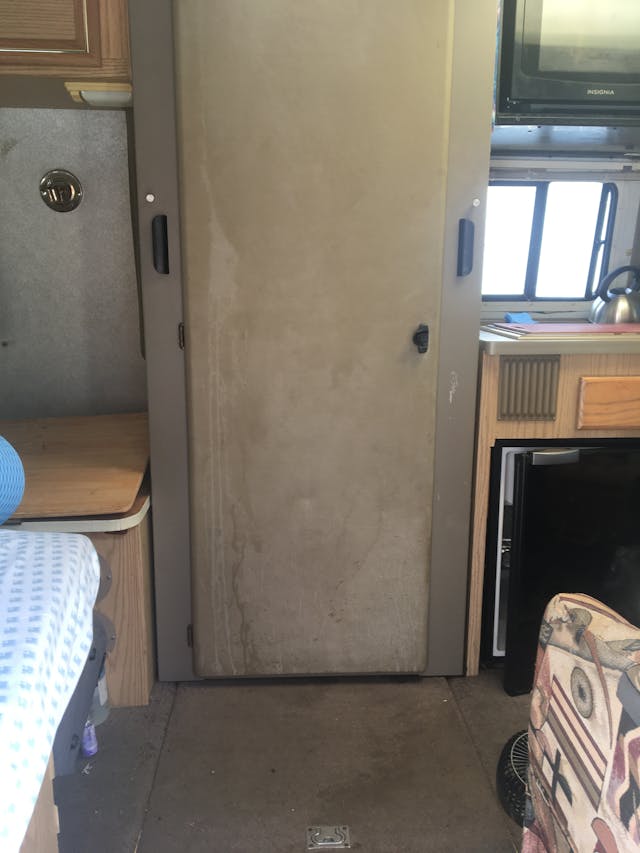

We almost never use the shower, as the Rialta’s gray water tank is so small that we’d need to dump it daily if we did. Instead, we use the showers at the campgrounds. They’re less private, but they have a lot more space and hot water. Regardless, the shower drain location forced by the wet-bath configuration creates a problem.
As you can see from the above photo, the shower drain is in a recess in the rear right of the pan. For the five years we’ve owned the RV, there’s been a minor freshwater leak that causes water to accumulate in the drain recess. Since the fresh-water hookup for campground water comes in through the wall behind the shower, I always assumed the leak was coming from there. For years, when there was enough water there to be concerned about, I’d simply turn on the shower drain pump and have it suck the water from there into the gray water tank.
The problem is that, because of the shared pan, even if you don’t use the shower, a lot of dirt and grit winds up in that drain, and it shockingly doesn’t have a filter there—the filter is instead a screen on the inlet of the shower pump, which is accessible via a hole cut in the platform holding one of the twin mattresses.
So that’s background for my explaining that, when my wife and I were ready to leave the campground in the RV and drive down to the beach, we noticed that the rug was wet. I pulled floor section up and found that the entire shower pan was filled with water, and any driving was making it slosh over onto the rug. I thought, no problem—I’ll just hit the switch and run the shower drain pump. I could hear the pump run, but unfortunately it had no effect.
So, what’s the move here? With my aching back, I didn’t want to go through the contortions of having to pull off the mattress and check the filter through the access hole.


Then I remembered that this same thing had happened shortly after we’d bought the RV, and since necessity’s the mother of invention, I’d discovered that a remarkably effective way to drain the shallow pan is by using a plastic bag. Maire Anne is endlessly good-natured and helpful in these matters, so I pressed her into plastic bag bailing service. In a few minutes we had it dry enough to prevent sloshing while driving.

When I got home and my back had recovered enough to bend again, I looked at both the source of the leak and the drain problem. It turned out the leak was coming not from the RV’s fresh-water inlet like I’d thought, but from the toilet’s input valve. I discovered that it would also leak if I was turning on the RV’s fresh-water pump (the thing that wouldn’t work during the last trip) to pump water from the internal tank, but as the pressure was lower and the pump was only switched on when we needed to use it, it would leak slower than when connected to external water. I did some reading and learned that the toilet’s input valve is replaceable, but you have to remove the toilet to change it, and other things on the 26-year-old toilet are likely to go, and the smart move is to replace the whole thing. So a new toilet is on order.
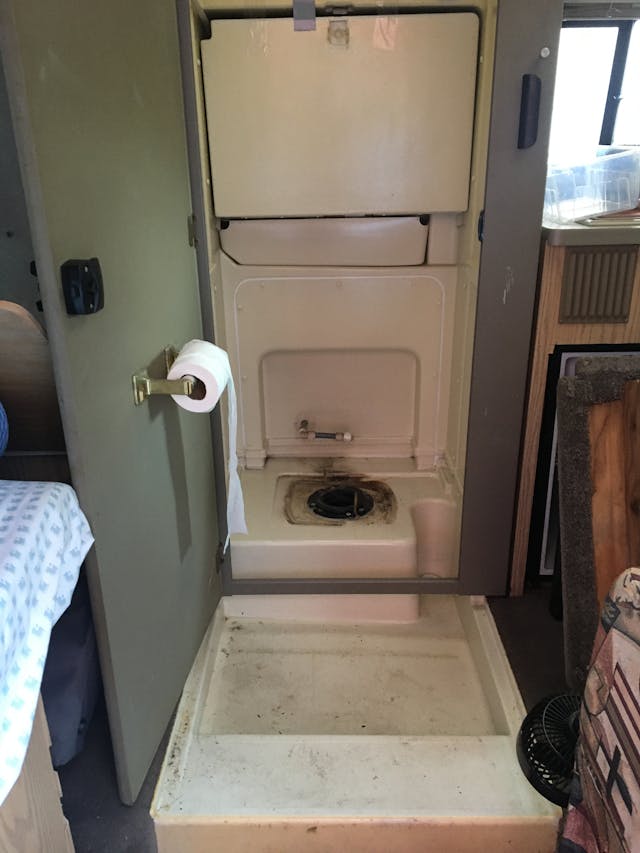
That left the shower drain to be repaired. Drain problems resulting from both clogs and vacuum leaks are common. Just like with a fuel pump in a car, if there’s a split in a hose or a bad seal, it’ll suck air instead of fuel. As I said, five years ago I tangled with this same problem. At that time, I discovered that someone had assembled the filter screen without an o-ring, and finding a right-sized o-ring fixed the vacuum leak and made the shower pump work. This time I checked the filter and found that the o-ring was intact, but the screen had a lot of gunk on it. I cleaned it, but the pump still didn’t move water.
The method here is to do pretty much what I described in this piece about troubleshooting a mechanical fuel pump in a car—determine whether the problem is in the pump or in the lines connecting it to what it’s trying to suck. The plumbing in many RVs uses NPSM (National Standard Pipe Straight Mechanical) fittings with a conical sealing washer. I ordered a 90-degree NPSM to PEX adapter and clamped a hose to it, then unscrewed the filter from the pump, put the adapter in its place, stuck the other end of the hose in a bucket of water, and turned on the pump. The pump ran, but to my surprise, it moved no water.

Before assuming that the pump had gone bad, I remembered that while these pumps are supposedly self-priming, sometimes they need to be primed—to have water filling the pump cavity and the hose to get them going. I poured water into the hose, stuck the other end into the bucket, and hit the switch again. This time it worked like a charm.
I then began to reinstall the filter and noticed that the conical washer at the inlet was misaligned and gashed. I miraculously found the bag of conical washers I’d ordered five years ago in a drawer in the RV (how often does that happen?), replaced the gashed washer, put the test hose on the inlet side of the filter, and primed it. Again, success.

The only thing left was to try it again with the actual drain line. Rather than pull all that dirty water through the pump’s filter, I sucked it all out of the recess with a shop vac, blew the line clear with compressed air, reconnected it, and primed it with a thin section of garden hose with the end cut off so I could snake it down the drain line. Bingo.
So, did it not work because of the gashed conical washer, the dirty pump screen, or because the line needed to be primed—or some combination? Don’t know, don’t care. It works perfectly now. I installed a little screen over the drain recess so dirt should now get caught there first—much easier to clean than the one under the mattress. And I put that priming garden hose in one of the RV’s cabinets just in case it happens again while on the road.
There were a few other non-essential but satisfying mods prior to this trip as well. I removed the original non-functional microwave, opened it up to fix it, found both a broken wire and a big mouse nest, and replaced it with a brand-new certified mouse-free microwave. Finding one that fit the space close enough to look like it belongs there was challenging, as was installing it so it won’t slide out, but now we can zap the leftovers from the restaurant, and I can heat up my coffee when I don’t drink it quickly enough.
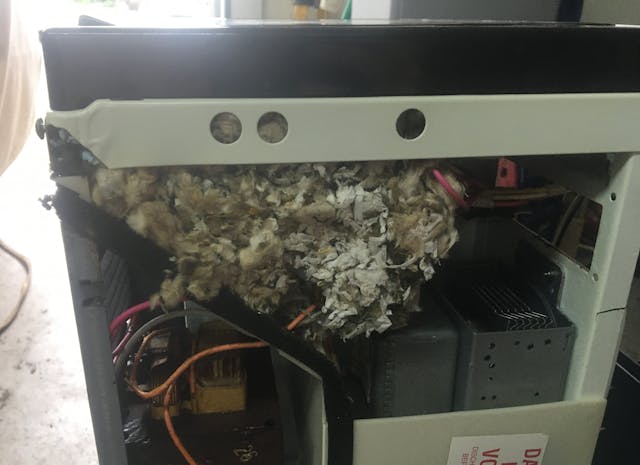

I mounted a little ducted exhaust fan behind the refrigerator so the heat on the condenser doesn’t build up in the small space behind it. I installed a 24-inch TV/DVD that runs off both 120 VAC and 12V DC so it can be used with and without shore power and mounted it on a retractable swivel mount so I can swing it out of the way when it’s not in use.
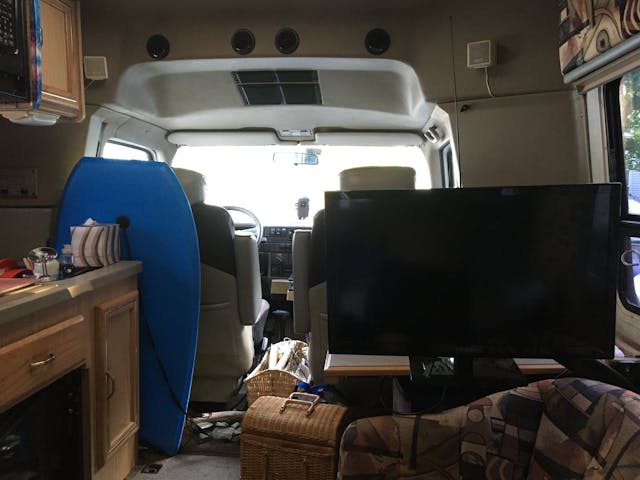
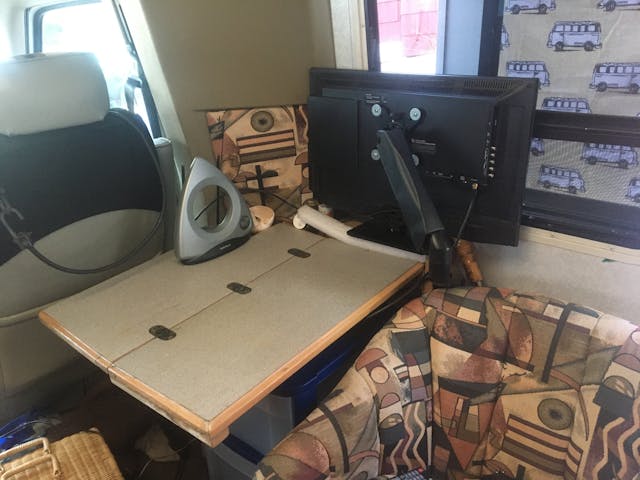
And, since I had it already, I installed an old Cambridge Soundworks system with two satellite speakers and a small, powered subwoofer that also runs off both 120 VAC and 12V DC. This way we can get good sound out of the television, as well as connect our phones when we’re either stopped or driving (the in-dash CD player doesn’t have an aux port or a Bluetooth connection). Most satisfying … until the 120 VAC went out due to a tripped ground fault interrupter that I couldn’t find until after we got home, and the sound system hummed like the low note on a pipe organ due to some sort of 12V DC ground loop.
Really, the point of all of this is that you, or you and your spouse, either roll with this stuff or you don’t. Personally, sitting either inside or outside an RV at a campsite reading a book isn’t really my thing, so I love having little self-contained problems to solve. If that’s not your speed, pony up the hundred large for a new RV or try to play the new-enough-that-it-won’t-break game. If you don’t have that kind of coin, stay in hotels instead.
***
Rob Siegel’s latest book, The Best of the Hack MechanicTM: 35 years of hacks, kluges, and assorted automotive mayhem, is available on Amazon. His other seven books are available here, or you can order personally inscribed copies through his website, www.robsiegel.com.

